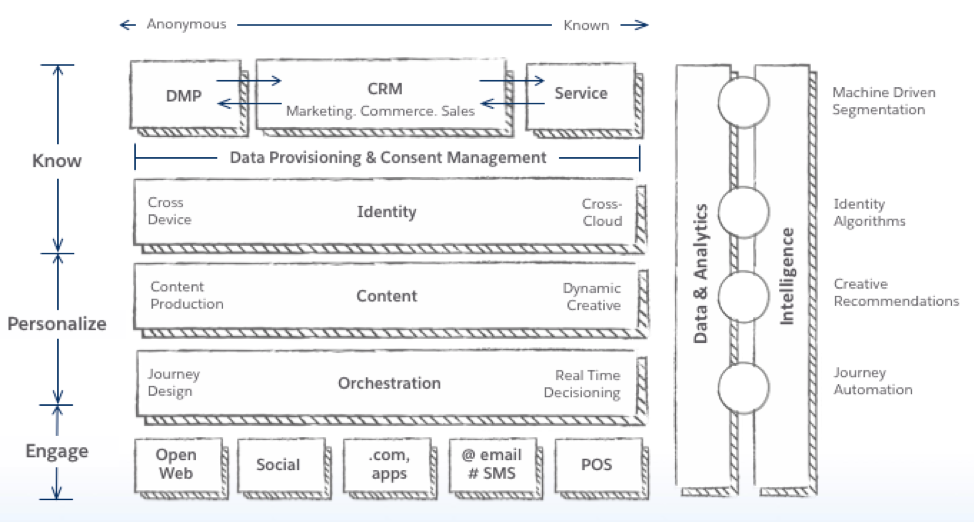Consumer Engagement Platform – Update

A few months back we wrote about the Consumer Engagement Platform, and how to make some sense of the broad options in marketing technology as marketers are building out and innovating their tech stacks to meet the growing demands of today’s digitally complex consumer.
There have been some interesting developments since then:
- Large Analytics acquisitions of Tableau (by Salesforce) and Looker (by Google)
- Proliferation of the CDP (Customer Data Platform), and Marketing Clouds announcing their own
- Enhanced Data Science availability for marketers
Evolution of the Consumer Engagement Platform
The core of the CEP (Audience, Personalization and Engagement) should continue to innovate – with more robust identity layers, and consumer consent tools that have the potential to enable hyper-personalization. Dynamic decisioning and orchestration is supplementing Journey Builder tools, and a single view of the customer is capturing audience signals from broader data sets.
Data models underpinning the engagement platform are evolving, to include multi-dimensions of campaign engagement, audience attributes, and creative/content data (seemingly in that order). Data visualization tools have the potential to sit on richer, connected data sets, which should translate into better insights. However, for actionability, the unified data set and visualization tools still miss important functionality – accessible and advanced data science.
Democratization of Data Science for Marketing
Data Science is the critical missing piece and next frontier for most marketing tech stacks, especially as brands continue to compete on customer experience in increasingly complex marketing environments.
Recent advancements in Data Science capability are driving competitive advantage for first movers:
- Machine learning in production, operating at scale
- Lightning fast customer provisioning and data science notebook delivery
- Proprietary visualizations focused on actionable recommendations
Marketing Data Science platforms like conDati are making it easy for brands to access the insights and actionable recommendations that come from robust machine learning and data science procedures.
In the coming blog series, we’ll unpack the 3 “starter set” focal points where marketers are building out the Intelligence Layer of the consumer engagement platform:
Optimization. Machine Learning optimization algorithms are scanning through multiple dimensions of campaigns – audience and creative attributes and recommending granular bid adjustments that are designed to increase lower funnel conversions. These bid adjustments are renewed weekly, at scale, according to where a specific audience / creative attribute is on its saturation curve for maximum utility. Recommended bid adjustments can be review then uploaded in one click to platforms like Google and Facebook, or through an automated feed. In addition, our Statistical and Network Attribution model recommends offers a non-biased optimized budget allocation across specific channels and campaigns.
The results have been tremendous. For a B2B Technology brand, we saw a +2.7x increase in lower funnel conversions, at a -30% reduced cost per conversion – creating millions of dollars of revenue opportunity.
Forecasting. Forecasting procedures are modeling business seasonality and crunching business drivers into real time forecasting of Revenue and Marketing KPIs. At conDati, the procedure is dialed in to the point where we can deliver a forecast within days of data capture through our unique parallel processing approach to building forecasting models.
In addition to providing important visibility into Revenue and KPI performance, built in anomaly detection and Send Optimization highlights potential shortfalls and recommends appropriate action. For example, at an e-commerce client our approach helped turn a potential revenue miss into 4% revenue growth over a quarter.
Propensity Scoring and Customer Lifetime Value. It starts with full funnel visibility – how marketing spend creates brand awareness and engagement, which leads to product trial then repeat purchase and spend growth. Regression models build propensities at various steps in the funnel by customer type and provide actionable recommendations for next best action. It all starts to come full circle when CLV (Customer Lifetime Value) is used to determine upper funnel spending and engagement decisions.
Looking forward to digging into all these topics and more in the coming weeks.



